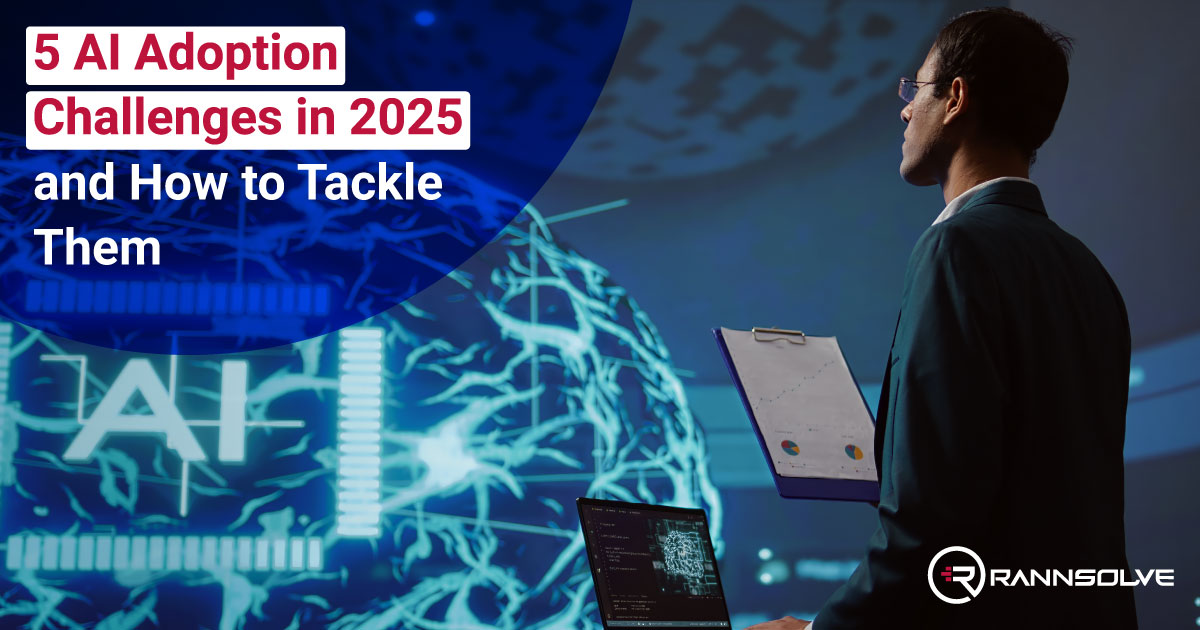It’s 2025, and there’s no denying that AI has moved beyond hype. It’s here, embedded in the tools we use, the systems we build, and the decisions we make. But that doesn’t mean it’s smooth sailing for every company trying to put it to work.
There’s a lot of talk about AI application development that’s transforming everything, but much less talk about the gritty, behind-the-scenes work it takes to get there. The truth is, many companies hit the same roadblocks when trying to bring AI into their business. Some are technical. Others are organizational. Most are advantageous, but only if you know what you’re dealing with.
Let’s break down the five most common challenges companies are still facing with AI adoption in 2025
1. Data Quality and Availability
A lot of teams are trying to build smart systems on top of weak foundations. Which means missing records, outdated fields, and inconsistent formats. You can’t expect good results when the input itself is flawed. And yet, this remains one of the most common problems in AI adoption. Even when the data exists, it’s often locked up in archives, stuck in legacy formats, or buried under layers of pending reviews. In heavily regulated industries, sharing data gets even trickier. So AI models have limited access and get trained on what’s available, not what’s needed for growth. And then there’s bias, which is another concern. If historical data reflects outdated practices or skewed representation, those same biases get baked into the systems you build, which might raise questions on ethical and operational risks.
Fixing this means investing in better data practices. That includes more rigorous data governance, making sure datasets are diverse and representative, and regularly auditing what the AI models are learning.
2. IT Infrastructure and Integration
A lot of companies jump into AI application development without realizing their existing technology just isn’t ready for it.
Big models need bigger and better memory, speed, and storage. And older systems weren’t built for that kind of load. So when teams try to plug in advanced AI tools, the result is often lagging performance, downtime, or expensive damage control.
The issue is especially obvious in companies running on legacy software and getting AI to work smoothly in environments built a decade ago, which may be barely doable, but not sustainable.
Building out the infrastructure to support AI—from cloud services to data pipelines—can be expensive. For small and mid-sized businesses, that upfront investment can feel like too much.
But here’s the good news: not every company needs AI application development from scratch. With cloud-based tools, hybrid approaches, and modular platforms, there are plenty of ways to modernize systems and get custom AI solutions without blowing up budgets. It just takes planning and a bit of restraint.
3. Privacy and Confidentiality
Data privacy is one of those things that’s always important, and with AI, it becomes even more critical. Because AI models don’t just process data, they learn from it. If you’re feeding sensitive information like customer data, internal documents, or proprietary details into a system, you need to be sure that your AI model is following security protocols.That means things like anonymizing personal data, encrypting inputs, setting strict access controls, and making sure everything’s logged and auditable. A lot of companies are getting smarter about this, especially with regulations tightening across regions.
4. Lack of expertise and skills
This one’s as simple as it is painful: there just aren’t enough skilled professionals to depend on. Building and maintaining AI systems requires a mix of roles: data scientists, engineers, analysts, product people, and often someone who understands the ethical implications, too. But most companies don’t have all of those in-house. And the ones who do are competing fiercely to keep them.
The smart solution isn’t always hiring; it’s also upskilling. Teaching existing teams how to work with AI, even if they’re not building the models themselves, goes a long way. So does bringing in external help by partnering with the right AI service provider.
5. Low Expectations on the ROI
If you’re spending on AI without knowing what “success” looks like, you’re setting yourself up for disappointment. A lot of businesses jump into AI hoping it’ll solve big problems or deliver big savings. But without a clear path, it’s easy for things to stall—or get quietly shelved after a few months of pilot testing.
The challenge here isn’t that AI doesn’t deliver ROI. It’s that the return isn’t always immediate or obvious. Sometimes the impact shows up as efficiency gains or faster decision-making, not just dollars saved. But without metrics or benchmarks, it all feels too abstract.To fix this, companies need to treat AI like any other investment. Start with the business problem. Work backward to the solution. Track outcomes. Be realistic about timelines. AI works best when it’s aimed at something specific.
How to Tackle the AI Adoption Challenges in 2025
Remember that the businesses doing it well aren’t rushing. They’re being thoughtful, asking tough questions, and focusing on foundations first.
You don’t need to build everything from scratch. Some problems are best solved with pre-built tools. Others need custom models. What matters is matching the approach to the problem. Hybrid systems, open-source tools, and existing cloud platforms can offer flexibility without overcomplicating things.
Another way to overcome the challenges of AI adoption and generative AI implementation is partnering with the right AI service provider. The right partner doesn’t just provide technology—they bring strategic insight, industry-specific expertise, and a proven track record of success. Even better, they offer custom AI solutions and services tailored to your industry and business goals.
Rannsolve, Your AI Services and Solutions Partner
Rannsolve’s team of AI experts brings a proven track record of successful automation deployments across industries, offering clients a roadmap to AI best practices and measurable ROI with generative AI implementation. Our AI-powered suite of CDE, CPA, and CCR fits seamlessly into your existing workflows.
Transform your operations with AI and intelligent automation today!
Click here for a free demo!





